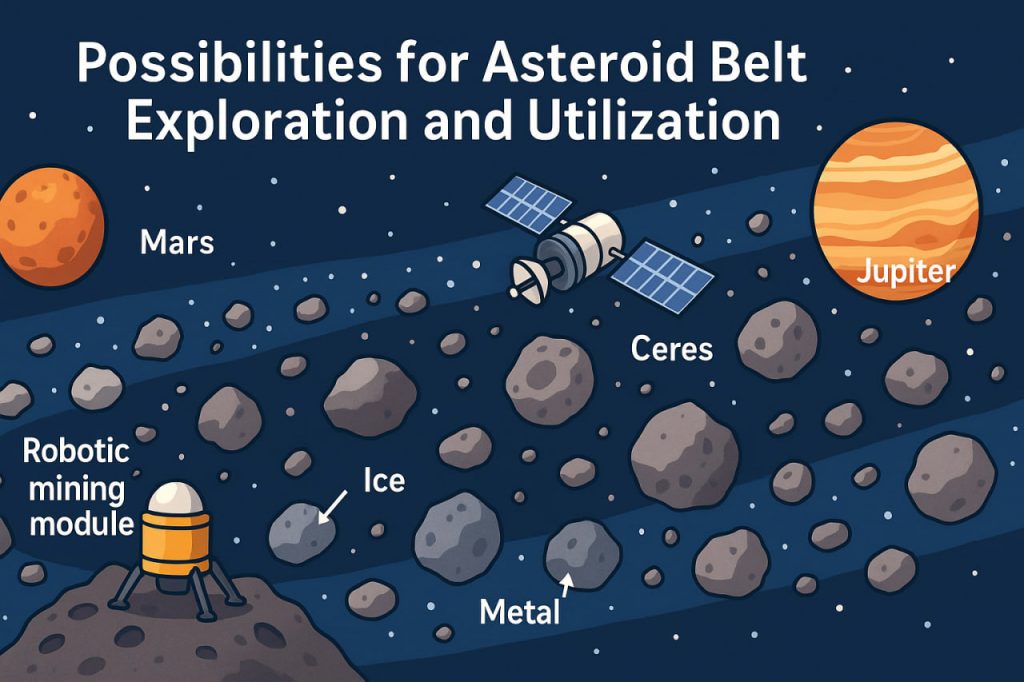The asteroid belt is a vast region between Mars and Jupiter filled with rocky remnants from the early Solar System. Far from being just a chaotic zone of floating debris, it presents immense potential for scientific exploration, resource extraction, and possibly even future space colonization. As technology advances, so does our ability to access and benefit from this unique region.
What Is the Asteroid Belt?
The asteroid belt contains millions of rocky bodies, ranging in size from tiny dust particles to dwarf planet Ceres, which is nearly 1,000 km in diameter. These asteroids are composed primarily of:
- Carbonaceous (C-type) materials
- Silicaceous (S-type) minerals
- Metallic (M-type) elements, rich in iron and nickel
Because of their primitive composition, these bodies offer insights into Solar System formation and may hold water ice and precious metals.
Why Explore the Asteroid Belt?
- Scientific Knowledge
Studying asteroids reveals clues about the early Solar System. Some may contain organic molecules or water, helping us understand the origins of Earth’s water and possibly life. - Resource Mining
The belt may contain trillions of dollars’ worth of materials such as:- Iron, nickel, and platinum-group metals
- Water for life support and rocket fuel production
- Rare Earth elements useful in electronics and energy systems
- Fuel Stations for Deep Space Missions
Water extracted from asteroids can be split into hydrogen and oxygen, providing in-situ propellant for spacecraft. This could make deep space travel more sustainable. - Reduced Launch Costs
Mining asteroids directly in space avoids the expense and environmental impact of launching heavy materials from Earth’s gravity well.
Challenges of Utilizing the Asteroid Belt
- Distance: It lies ~300-500 million km from Earth, requiring long and costly missions
- Microgravity environments make landing, anchoring, and mining very difficult
- Radiation and temperature extremes require durable equipment and protective systems
- Legal and ethical issues: Who owns the resources? Current space law is still evolving
Current and Future Missions
Several space agencies and private companies are already laying the groundwork:
- NASA’s Dawn Mission: Studied Vesta and Ceres, proving we can orbit and explore asteroids
- Japan’s Hayabusa and Hayabusa2: Returned asteroid samples to Earth
- NASA’s OSIRIS-REx: Delivered material from asteroid Bennu in 2023
- ESA’s Hera and NASA’s DART missions are testing asteroid deflection technologies
Private companies like Planetary Resources and Asteroid Mining Corporation aim to commercialize mining in the coming decades.
Future Possibilities
- Robotic mining outposts may be the first to extract valuable materials
- Human missions to Ceres or large asteroids could serve as stepping stones to deeper space
- Space-based manufacturing hubs using asteroid resources might reduce Earth’s industrial load
- Long-term, asteroid colonies could support deep space science and habitation
Conclusion
The asteroid belt represents a massive opportunity for advancing human space capabilities. Whether as a source of critical resources, a platform for scientific discovery, or a waypoint for interplanetary travel, its value is undeniable. While technical and legal hurdles remain, the roadmap to unlocking this treasure trove is steadily becoming reality.
Glossary
- Ceres: The largest object in the asteroid belt, classified as a dwarf planet
- In-situ resource utilization (ISRU): Using local materials in space instead of bringing them from Earth
- Microgravity: A condition of very low gravity often experienced in space
- Solar System formation: The process by which the Sun and planets developed from a nebula
- DART Mission: A planetary defense test to redirect an asteroid’s trajectory


